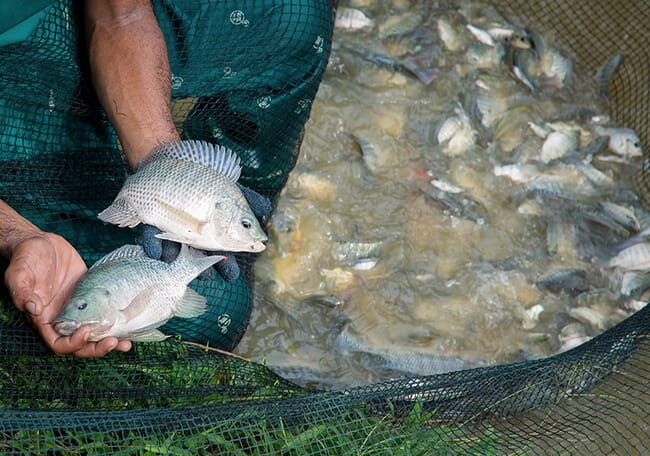
© WorldFish
A study taking place in Brazil revealed that environmental enrichment, in the form of artificial aquatic plants and shelters, can significantly improve tilapia welfare by reducing stereotypical and aggressive behaviour.
The study was conducted in the Experimental Farm Campus of the Aquaculture Sector of the Faculty of Veterinary Medicine and Animal Science at São Paulo State University (UNESP). It involved 640 juvenile Nile tilapia (Oreochromis niloticus) males originating from a sex-reversed GIFT population.
The first treatment was composed of environmental enrichment, using PVC pipes, 10 cm in diameter and 20 cm in length, for shelter. The second used artificial water hyacinths (frayed nylon rope simulating the natural water hyacinth root) fixed to styrofoam structures or to the aquarium itself. The third treatment was outlined with food supplementation with the amino acid tryptophan supplemented to the diet at 2.56 percent by weight. The fourth treatment was a control tank without enrichment or supplemented food.
An analysis of aggressive behaviour showed lower numbers of confrontations in the tanks where the food had been supplemented with tryptophan food-supplemented treatment compared to the control and environmental enriched treatments. This is because it is a serotonin precursor, a neurotransmitter involved in the control of aggressive behaviour and the susceptibility to stress.
On the other hand water hyacinth and shelter presented high levels of confrontation.
“Despite the benefits, enriched environments can generate competition between territorial fish, which means more confrontations,” the researchers noted.
However, they also noted that environments enriched with artificial water hyacinth and shelters led to less intense confrontations, which were mostly threats rather than fighting, and concentrated at the section with enrichment items. In the control situation the occurrence of these confrontations were more intense – leading to pursuits, lateral confrontation, and bites – and occurred through the entire aquarium region.
They also noted that opercular beat frequency – another sign of stress – was lowest for the tilapia whose tanks were enriched with artificial water hyacinth.
The researchers also questioned whether the tryptophan supplementation was sufficient to act as an alternative to environmental enrichment as a means to enhance animal welfare, as their trial showed that scratching behaviour increased in the tryptophan treatment relative to the environmental enrichment treatments.
Conclusion
The researchers conclude by stating that “a poor environment in fish farming has deficiencies that can be improved by including proposed enrichments, filling a fish need to express natural behavior, improving the quality of life for animals. We can highlight artificial water hyacinths as the treatment that presented the best and most consistent results. Such a means of environmental enrichment can be easily implemented in fish farms since it is low cost, easy to handle, and highly durable.”
Further information
The results of the study were published in Aquaculture Reports, under the title “Environmental enrichment techniques and tryptophan supplementation used to improve the quality of life and animal welfare of Nile tilapia”.



